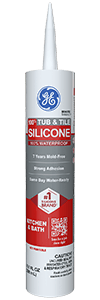Between washing dishes, prepping food and cleaning, your kitchen sink has to stand up to a lot of daily wear and tear. That’s why it’s particularly important for your sink to have a durable, watertight seal. Old, damaged sealant or a sealant that isn’t 100% waterproof can let water and moisture seep between your sink and counters, which can create leaks in your cabinets or lead to problems like mold, mildew and rot. Knowing how to seal a kitchen sink properly with a 100% silicone sealant will prevent these problems before they start.
Tools & Supplies for Sealing Sinks
Picking the right sealant can make all the difference. For sealing a kitchen sink, or anywhere water could be present, choose a GE-branded 100% silicone sealant, like GE Tub & Tile Silicone 1® sealant. This sealant is 100% waterproof, permanently flexible and has 7-year mold-free product protection,1 so you can create a lasting, mold-resistant and watertight seal.
Whichever product you choose, check the packaging to ensure the sealant will adhere to your countertop material without staining it.
Pro Tip: 100% silicone sealants are not paintable so be sure to pick the appropriate color for your project.
Besides a GE-branded 100% silicone sealant, you will also need:
- Caulk gun
- Painter’s tape
- Latex gloves
- Soapy water
- Paper towels
- Utility blade
- Caulk tool
- Mineral spirits
- Isopropyl alcohol
With all your tools and supplies ready, follow these steps to learn how to seal a kitchen sink so it has long-lasting, 100% waterproof protection:
-
Start with a Clean Surface
Whenever you start a new sealing project, make sure you have a clean work surface by wiping it down with isopropyl alcohol. If you’re replacing old caulk or sealant, completely remove it first, then wipe down the area with isopropyl alcohol. Let the surface dry before laying a new bead.
Safety Tip: Make sure your work area is well ventilated when using isopropyl alcohol.
-
Apply Painter’s Tape
For a smoother bead and easier cleanup, apply painter’s tape on either side of the area you’re sealing.
-
Carefully Cut the Sealant Cartridge
Next, prepare your sealant by cutting the tip of the cartridge. Cut the cartridge tip at a 45-degree angle so the hole is about the same size as the area you’re sealing. Some caulk guns have a tool to cut the cartridge tip, but we recommend using a utility blade for consistently clean results. Cut off less than you think you’ll need because you can always cut more. Once cut, pierce the cartridge’s inner foil seal using the metal rod on your caulk gun or a long nail. Then load the sealant cartridge into the caulk gun.
-
Apply Sealant
After prepping your sealant and your work area, start running a bead of sealant around the entire sink where it meets the countertop. Start at one corner of the sink and work your way around. Pull the gun toward you and maintain a relaxed, confident grip and steady speed to apply the bead smoothly. If you can’t make it in one pass, it’s ok to readjust your grip and start where you left off. Fill gaps with additional sealant as needed.
-
Tool the Bead & Remove the Painter’s Tape
Use a caulk tool or your finger to tool the sealant bead until it’s smooth. It’s important to tool the bead before the sealant starts to cure, so if you need to, you can tool in sections. Run a bead of sealant in one manageable section, like along one edge of the sink, tool the bead, then continue applying more sealant.
-
Let Sealant Cure Completely
Finally, allow the sealant to cure completely for the best performance. GE Tub & Tile Silicone 1® sealant is same-day water-ready2 and fully cured in 24 hours, but check your product for specific curing instructions.Once the sealant has cured, your kitchen sink will be watertight and ready to use. For more step-by-step sealing tutorials with high-performing GE-branded sealants, check out our other How-To guides.
1Cured sealant is resistant to stain causing mold and mildew. Regular cleaning of the cured sealant is required, however, as soap and other residue can cause secondary mold and mildew growth.
2Exposure to water possible in as little as 12 hours with bead size max 3/16″, temperature min 65°F and humidity min 50%. Do not touch or clean sealant for 24 hours.

